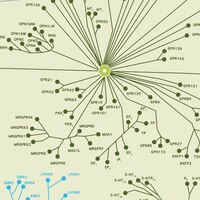HTS142M
Sigma-AldrichChemiScreen™ Membrane Preparation
Recombinant Human EP4 Prostanoid Receptor
Human EP4 GPCR membrane preparation for Radioligand binding Assays & GTPγS binding.
More>> Human EP4 GPCR membrane preparation for Radioligand binding Assays & GTPγS binding. Less<<Recommended Products
Overview
| Replacement Information |
|---|
Key Specifications Table
| Species | Host Cells | Protein Target |
|---|---|---|
| Human | Chem-1 | EP4 |
| References |
|---|
| Product Information | |
|---|---|
| Format | Membranes |
| Presentation | One package contains enough membranes for at least 200 assays (units), where an unit is the amount of membrane that will yield greater than 3-fold signal:background with 3H-labeled prostaglandin E2 at 1.5 nM. Liquid in packaging buffer: 50 mM Tris pH 7.4, 10% glycerol and 1% BSA with no preservatives. Packaging method: Membranes protein were adjusted to the indicated concentration in packaging buffer, rapidly frozen, and stored at -80°C. |
| Quality Level | MQ100 |
| Physicochemical Information |
|---|
| Dimensions |
|---|
| Materials Information |
|---|
| Toxicological Information |
|---|
| Safety Information according to GHS |
|---|
| Safety Information |
|---|
| Storage and Shipping Information | |
|---|---|
| Storage Conditions | Maintain frozen at -70°C for up to 2 years. Do not freeze and thaw. |
| Packaging Information | |
|---|---|
| Material Size | 200 units |
| Transport Information |
|---|
| Supplemental Information |
|---|
| Specifications |
|---|
| Global Trade Item Number | |
|---|---|
| Catalog Number | GTIN |
| HTS142M | 04053252325236 |
Documentation
ChemiScreen™ Membrane Preparation
Recombinant Human EP4 Prostanoid Receptor SDS
| Title |
|---|
ChemiScreen™ Membrane Preparation
Recombinant Human EP4 Prostanoid Receptor Certificates of Analysis
| Title | Lot Number |
|---|---|
| CHEMISCREENTM MEMBRANE PREPARATION RECOMBINANT HUMAN EP4 PROSTANOID RECEPTOR - 2188021 | 2188021 |
References
| Reference overview | Pub Med ID |
|---|---|
| Stimulation of bone formation and prevention of bone loss by prostaglandin E EP4 receptor activation Yoshida, Keiji, et al Proc Natl Acad Sci USA, 99:4580-5 (2002) 2002 | 11917107
 |
| Genetic and pharmacological analysis of prostanoid receptor function Narumiya, S and FitzGerald, G A J Clin Invest, 108:25-30 (2001) 2001 | 11435452
 |
| The prostaglandin receptor EP4 triggers remodelling of the cardiovascular system at birth Nguyen, M, et al Nature, 390:78-81 (1997) 1997 | 9363893
 |












